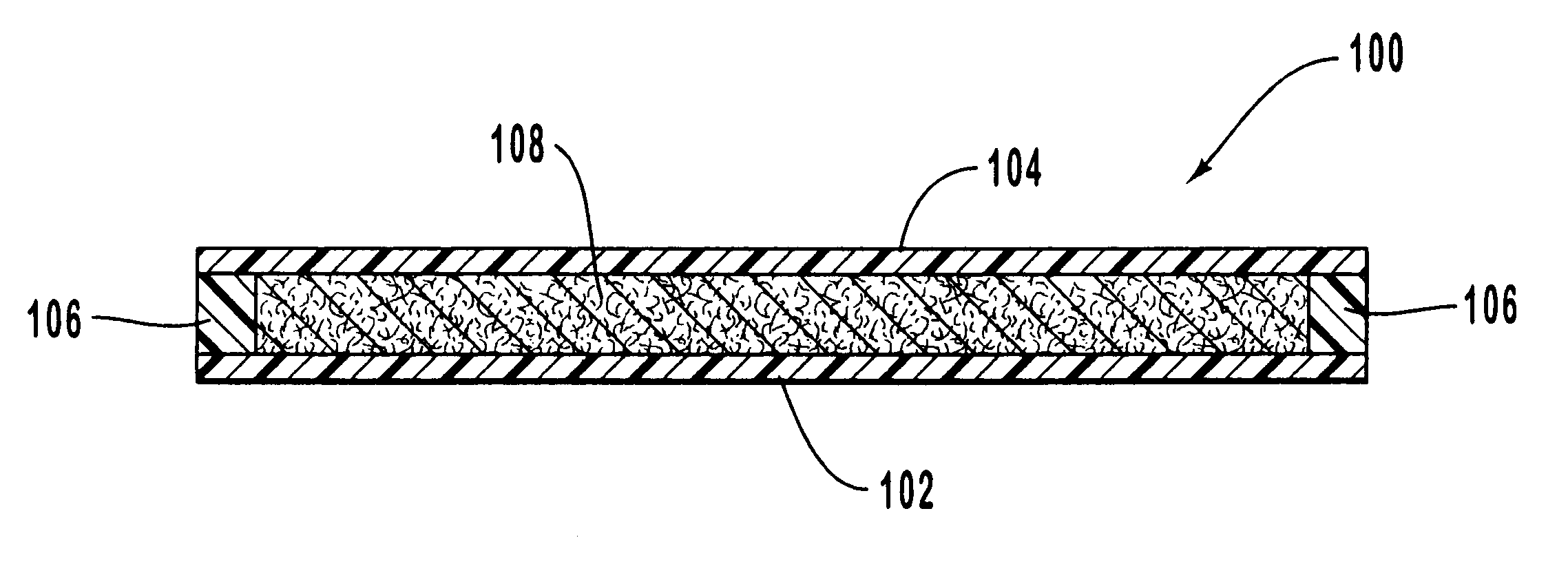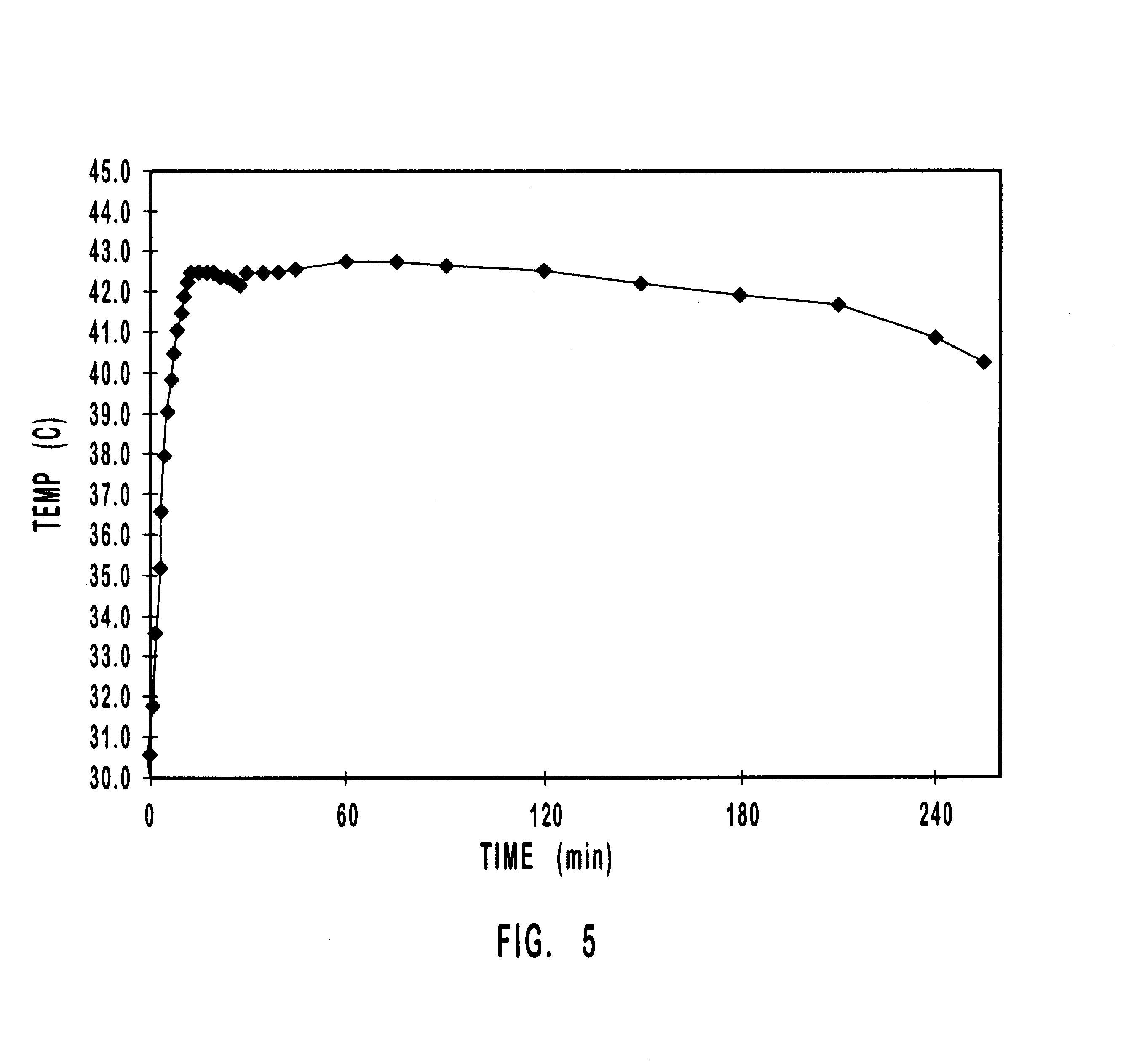Apparatus for heating to a desired temperature for improved administration of pharmaceutically active compounds
a technology of pharmaceutically active compounds and apparatuses, which is applied in the direction of drug compositions, contraceptive devices, and treatment, etc., can solve the problems of not having a design for altering the delivery rate of existing ddds, unsatisfactory intended effects, and unsatisfactory side effects
- Summary
- Abstract
- Description
- Claims
- Application Information
AI Technical Summary
Problems solved by technology
Method used
Image
Examples
example 1
One example of using the embodiment of the present invention illustrated in FIGS. 2-4 for administering analgesic material for relief of pain consists of a patient or care giver placing the DDDS 120 on the skin 134 of the patient, which preferably adheres to the skin 134 with DDDS adhesive 132. The patient or care giver then attaches the temperature control apparatus 100 on top of the DDDS 120, which adheres to the DDDS 120 with temperature control apparatus adhesive 112. Oxygen in ambient air flows into the temperature regulating mechanism 108 through holes 114 and air permeable membrane 116. Of course, it is understood that the rate at which oxygen contacts the temperature regulating mechanism 108 is determined by the size and number of the holes 114 on the top wall 104, as well as the air permeability of the air permeable membrane 116. A heat generating (exothermic) chemical reaction occurs in the temperature regulating mechanism 108. Heat from this reaction passes through the te...
example 2
An example of using the embodiment of the present invention illustrated in FIGS. 8-12 for administering analgesic material to treat breakthrough pain consists of a patient or care giver placing the DDDS 160, 165 on the skin 134 of the patient with the temperature control apparatus 150 placed thereover. By way of example, when the DDDS 160, 165 is a commercially available fentanyl patch, Duragesic-50.RTM., it takes several hours after the application of the DDDS 160, 165 to obtain a sufficient steady state level of fentanyl in the patient's bloodstream to control baseline pain. However, such as with the treatment of cancer patients, a patient will from time to time suffer breakthrough pain, which is a suddenly increased but usually not long lasting pain. When a patient feels that a breakthrough pain episode is imminent, the patient places the temperature control apparatus 150 over the DDDS 160, 165. The heat from the temperature control apparatus 150 increases the temperature of the ...
example 3
Another example of using the embodiment of the present invention illustrated in FIGS. 8-12 for dermally administering nicotine for suppressing nicotine craving consists of a user placing a nicotine DDDS 160, 165 on the skin 134. After a few hours, the user should obtain a steady state nicotine concentration in the bloodstream that is sufficient to suppress a "baseline" nicotine craving. When the user starts to have an episode of increased nicotine craving, the user puts the temperature control apparatus 150 on top of the DDDS 160, 165. The temperature control apparatus 150 preferably heats for at least 15 minutes before the exothermic reaction exhausts the temperature regulating mechanism 108. The heat increases the transport of nicotine across the skin, and increases the blood flow in the tissues under the DDDS 160, 165 which carries nicotine stored in the tissues under the DDDS 160, 165 into the systemic circulation at increased rates. As a result, the user gets a rapid increase i...
PUM
| Property | Measurement | Unit |
|---|---|---|
| length of time | aaaaa | aaaaa |
| length of time | aaaaa | aaaaa |
| length of time | aaaaa | aaaaa |
Abstract
Description
Claims
Application Information
 Login to View More
Login to View More - R&D
- Intellectual Property
- Life Sciences
- Materials
- Tech Scout
- Unparalleled Data Quality
- Higher Quality Content
- 60% Fewer Hallucinations
Browse by: Latest US Patents, China's latest patents, Technical Efficacy Thesaurus, Application Domain, Technology Topic, Popular Technical Reports.
© 2025 PatSnap. All rights reserved.Legal|Privacy policy|Modern Slavery Act Transparency Statement|Sitemap|About US| Contact US: help@patsnap.com



